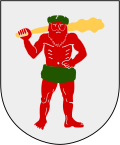Swedish Lapland
| Lappland | ||
|---|---|---|
|
||
 |
||
| Country | Sweden | |
| Land | Norrland | |
| Counties |
Västerbotten County Norrbotten County Jämtland County |
|
| Area | ||
| • Total | 109,702 km2 (42,356 sq mi) | |
| Population (2009) | ||
| • Total | 94,350 | |
| • Density | 0.86/km2 (2.2/sq mi) | |
| Ethnicity | ||
| • Language | Swedish, Sami | |
| Culture | ||
| • Flower | Mountain avens | |
| • Animal | Arctic fox | |
| • Bird | Bluethroat | |
| • Fish | Salvelinus | |
| Time zone | CET (UTC+1) | |
| • Summer (DST) | CEST (UTC+2) | |
Lappland, often Anglicized as Lapland (Swedish: Lappland, Latin: Lapponia, Northern Sami: Sápmi), is a province in northernmost Sweden. It borders Jämtland, Ångermanland, Västerbotten, Norrbotten, Norway and Finland. About a quarter of Sweden's surface area is in Lappland.
Lappland originally extended eastward. However, in 1809 the Russian Empire annexed the eastern part of the Swedish realm, and created the Grand Duchy of Finland, which in effect split Lappland into a Swedish part and a Finnish part, both of which still exist today.
The history of Lappland is in many ways connected to the history of Norrbotten County and Västerbotten County, since Lappland is a historic region connected to these counties. During the Middle Ages, Norrbotten/Lappland was considered a no man's land. The area was in fact populated by nomadic Sami people, but the region became increasingly settled by Swedish, Finnish and Norwegian settlers - especially along the coasts and large rivers. From the Middle Ages on, the Swedish kings tried to colonise and Christianise the area using settlers from what is now Finland and southern Sweden. Today, despite large-scale assimilation into the dominant Swedish culture, Finnish and Sami minorities continue to maintain their cultures and identities.
...
Wikipedia

